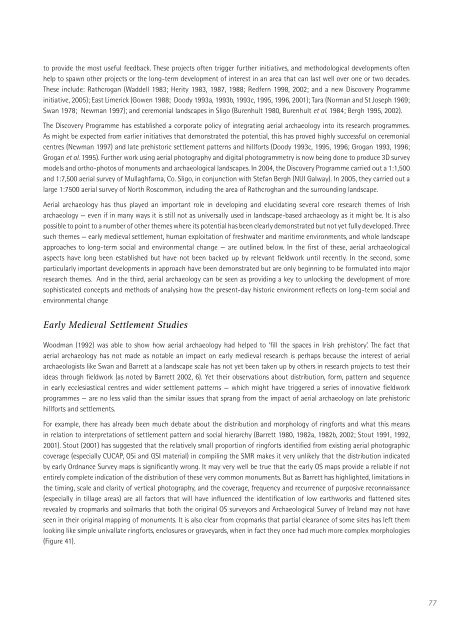Aerial Archaeology in Ireland - The Heritage Council
Aerial Archaeology in Ireland - The Heritage Council
Aerial Archaeology in Ireland - The Heritage Council
Create successful ePaper yourself
Turn your PDF publications into a flip-book with our unique Google optimized e-Paper software.
to provide the most useful feedback. <strong>The</strong>se projects often trigger further <strong>in</strong>itiatives, and methodological developments often<br />
help to spawn other projects or the long-term development of <strong>in</strong>terest <strong>in</strong> an area that can last well over one or two decades.<br />
<strong>The</strong>se <strong>in</strong>clude: Rathcrogan (Waddell 1983; Herity 1983, 1987, 1988; Redfern 1998, 2002; and a new Discovery Programme<br />
<strong>in</strong>itiative, 2005); East Limerick (Gowen 1988; Doody 1993a, 1993b, 1993c, 1995, 1996, 2001); Tara (Norman and St Joseph 1969;<br />
Swan 1978; Newman 1997); and ceremonial landscapes <strong>in</strong> Sligo (Burenhult 1980, Burenhult et al. 1984; Bergh 1995, 2002).<br />
<strong>The</strong> Discovery Programme has established a corporate policy of <strong>in</strong>tegrat<strong>in</strong>g aerial archaeology <strong>in</strong>to its research programmes.<br />
As might be expected from earlier <strong>in</strong>itiatives that demonstrated the potential, this has proved highly successful on ceremonial<br />
centres (Newman 1997) and late prehistoric settlement patterns and hillforts (Doody 1993c, 1995, 1996; Grogan 1993, 1996;<br />
Grogan et al. 1995). Further work us<strong>in</strong>g aerial photography and digital photogrammetry is now be<strong>in</strong>g done to produce 3D survey<br />
models and ortho-photos of monuments and archaeological landscapes. In 2004, the Discovery Programme carried out a 1:1,500<br />
and 1:7,500 aerial survey of Mullaghfarna, Co. Sligo, <strong>in</strong> conjunction with Stefan Bergh (NUI Galway). In 2005, they carried out a<br />
large 1:7500 aerial survey of North Roscommon, <strong>in</strong>clud<strong>in</strong>g the area of Rathcroghan and the surround<strong>in</strong>g landscape.<br />
<strong>Aerial</strong> archaeology has thus played an important role <strong>in</strong> develop<strong>in</strong>g and elucidat<strong>in</strong>g several core research themes of Irish<br />
archaeology — even if <strong>in</strong> many ways it is still not as universally used <strong>in</strong> landscape-based archaeology as it might be. It is also<br />
possible to po<strong>in</strong>t to a number of other themes where its potential has been clearly demonstrated but not yet fully developed. Three<br />
such themes — early medieval settlement, human exploitation of freshwater and maritime environments, and whole landscape<br />
approaches to long-term social and environmental change — are outl<strong>in</strong>ed below. In the first of these, aerial archaeological<br />
aspects have long been established but have not been backed up by relevant fieldwork until recently. In the second, some<br />
particularly important developments <strong>in</strong> approach have been demonstrated but are only beg<strong>in</strong>n<strong>in</strong>g to be formulated <strong>in</strong>to major<br />
research themes. And <strong>in</strong> the third, aerial archaeology can be seen as provid<strong>in</strong>g a key to unlock<strong>in</strong>g the development of more<br />
sophisticated concepts and methods of analys<strong>in</strong>g how the present-day historic environment reflects on long-term social and<br />
environmental change<br />
Early Medieval Settlement Studies<br />
Woodman (1992) was able to show how aerial archaeology had helped to ‘fill the spaces <strong>in</strong> Irish prehistory’. <strong>The</strong> fact that<br />
aerial archaeology has not made as notable an impact on early medieval research is perhaps because the <strong>in</strong>terest of aerial<br />
archaeologists like Swan and Barrett at a landscape scale has not yet been taken up by others <strong>in</strong> research projects to test their<br />
ideas through fieldwork (as noted by Barrett 2002, 6). Yet their observations about distribution, form, pattern and sequence<br />
<strong>in</strong> early ecclesiastical centres and wider settlement patterns — which might have triggered a series of <strong>in</strong>novative fieldwork<br />
programmes — are no less valid than the similar issues that sprang from the impact of aerial archaeology on late prehistoric<br />
hillforts and settlements.<br />
For example, there has already been much debate about the distribution and morphology of r<strong>in</strong>gforts and what this means<br />
<strong>in</strong> relation to <strong>in</strong>terpretations of settlement pattern and social hierarchy (Barrett 1980, 1982a, 1982b, 2002; Stout 1991, 1992,<br />
2001). Stout (2001) has suggested that the relatively small proportion of r<strong>in</strong>gforts identified from exist<strong>in</strong>g aerial photographic<br />
coverage (especially CUCAP, OSi and GSI material) <strong>in</strong> compil<strong>in</strong>g the SMR makes it very unlikely that the distribution <strong>in</strong>dicated<br />
by early Ordnance Survey maps is significantly wrong. It may very well be true that the early OS maps provide a reliable if not<br />
entirely complete <strong>in</strong>dication of the distribution of these very common monuments. But as Barrett has highlighted, limitations <strong>in</strong><br />
the tim<strong>in</strong>g, scale and clarity of vertical photography, and the coverage, frequency and recurrence of purposive reconnaissance<br />
(especially <strong>in</strong> tillage areas) are all factors that will have <strong>in</strong>fluenced the identification of low earthworks and flattened sites<br />
revealed by cropmarks and soilmarks that both the orig<strong>in</strong>al OS surveyors and Archaeological Survey of <strong>Ireland</strong> may not have<br />
seen <strong>in</strong> their orig<strong>in</strong>al mapp<strong>in</strong>g of monuments. It is also clear from cropmarks that partial clearance of some sites has left them<br />
look<strong>in</strong>g like simple univallate r<strong>in</strong>gforts, enclosures or graveyards, when <strong>in</strong> fact they once had much more complex morphologies<br />
(Figure 41).<br />
77

















